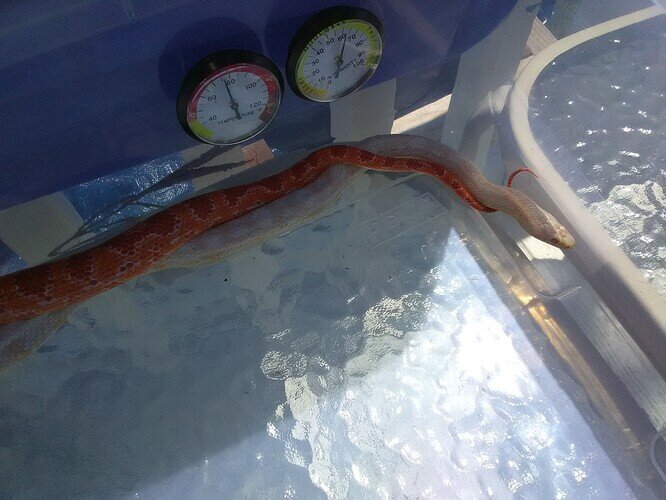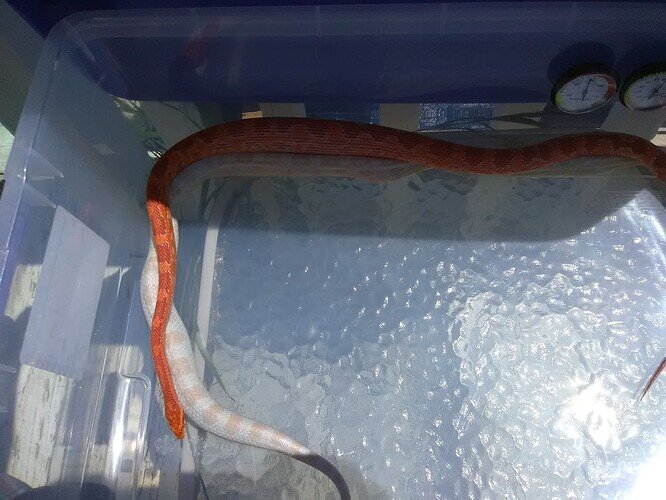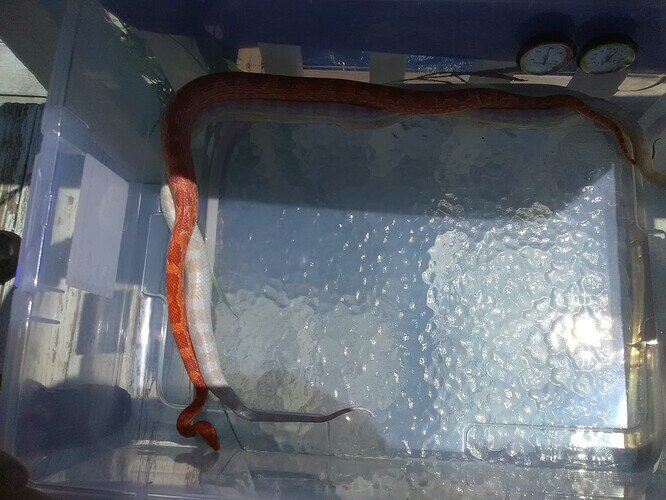A girl I work with is moving and has to re-home all her animals she gave me these two who seem very under sized for their ages and have never burmated. She said she’s sure the female is Opal but the boy she said is a bloodred, orange or fire. The girls is 340 grams and 5 or 6 years old, the boy is 280 grams and 9 or 10 years old. They were being fed once every two weeks, which seems too little to me. I keep ball pythons normally. I’d appreciate any advice. I’ve got some basics, but that’s all.
The male looks like a red factor amel to me, but a belly picture will help determine if he’s also diffused (fire). I would love to see more pictures of both of them. The female has more pattern than I’ve seen on other opals, but I would love to see some closeups of her face. Opals shouldn’t have any yellow and it’s hard to tell from these pictures if she has any or not. Very pretty snakes anyway!
Feeding every 2 weeks is pretty standard for adult corns. The male does sound pretty small for his age, but he doesn’t look thin. I would probably feed him a large adult mouse every 10 days until he hits 300 grams and then go back to once every 2 weeks. The female could stick with a large adult mouse every 2 weeks. What size/species prey were they being fed previously? Does he have a meal inside him in the last picture? Do the two of them live together?
This right here. If not, I’d say you’re going to need a vet check with that age/distended abdomen combo.
I’d actually consider asking the previous owner if his weight is typical or if this is a recent loss, just to be sure there’s no underlying issues before bumping up feedings. The fact that there are two adult animals with such a drastic weight difference seems…Interesting. Though if they were co-habbed, it’s entirely possible it was breeding season food refusal.
Also don’t forget to quarantine these two away from any other animals you may have, at least until you’re sure they’re healthy.
They didn’t live together, and yes he has a meal in him. She hasn’t eaten for the last three weeks. This was just a temporary tote until they got set up. I don’t want to bother them too much while he’s digesting. They had basic uv bulbs for heat/light, and a hard mix of sand and dirt as substrate.
They are set up in temporary totes with water, aspen bedding and a 85° heat pad(under the tote, on a thermostat)
They are quarantined in my bedroom, on the opposite side of the house from my snake room.
She didn’t seem to understand any of my questions. I also asked if they burmated (hibernated) and she didn’t know what I meant.
Glad to hear you’ve got them quarantined, and honestly it sounds like you might be a saving grace for these two if your co-worker didn’t have the ability to answer such basic questions. I would consider a vet check if you get a chance, just for a fecal float/parasite screen, since my guess is you don’t have any more info on their origins or anything else.
Other than that, @solarserpents gave great advice (and ID info), it sounds like you’ve got them set up properly, and aside that, corns are pretty easy to take care of. Every two weeks is normal for feeding, totally agree the little dude could handle every 10 days until he fills out a little, but it’s also possible he’s just an older snake who has more issue keeping weight on. Congrats on your new, absolutely gorgeous family members!
Sounds like you have them set up appropriately. And it’s okay if they weren’t brumated. A casual owner who doesn’t frequent hobby forums like this one may not even know what brumation is.
Not to mention, even in the hobby, many (myself included) don’t bother brumating corns. You can, especially if you want to cut down on food costs over winter, but it’s not necessary, especially if you don’t have the capability to get them to/keep them at temperature.
Thank you. I did try to give her help with her ball python care. She was only 300 grams in a 50 gallon with a red bulb for heat and just lots of moss for substrate. Just a hide and water dish for each of the snakes.
I don’t even keep BPs but just reading this made me cringe. Bare minimum with my corns is one hide per side, ground cover such as plastic foliage, cork, etc. With corns, they’re semi-arboreal, so for enrichment, giving them something like cork/mopani/other appropriate wood to climb on/hide in would be ideal.
What beautiful snakes! Sounds like they’re much better off with you.
They are lovely! How fortunate for them that they’re with you now. You’ve gotten excellent advice and ID points. I would definitely get a fecal check, just on general principles with rescues which is really what these are. I know with BP background, corns can look too slim and too small but I don’t think these necessarily are. It doesn’t sound like their needs were being met overall though. Do you know how/ what they were being fed?
When they’re settled in a bit, pics in natural light on a cloudy day week help with ID. I’m with Olivia, looks like likely Red Factor on the Amel. I kinda wonder if the female has something else going on. She’s got more color than most adult Opals. Are they by chance related?
I got a little more information today. They got the male about ten years ago from a pet shop. The female her brother got from a different pet shop about six years ago. The female was left with their mother for several months and only occasionally fed pinkies or fuzzies when someone would remind her. The pet shop the female was from listed her as Opal, the male was just “fancy”.
I just thought they were under weight going by the average adult size of 700-800 grams. And at 6-10 years old they should be bigger.
I don’t have a single adult that size, my largest is a male just under 600g. I wouldn’t really go by weight but more by length and body condition, and yours look just fine as they are. They may be a bit stunted, due to poor husbandry practices as well, but otherwise they look a healthy weight for their lengths.
Adult corn size can vary quite a bit, but I’d say the average for a healthy adult is in the 400-600 gram range. I’ve had larger ones, including one very long and muscular 800 gram girl and one very obese 800 gram girl, but most shouldn’t be that heavy.
I agree, that healthy adult corns are generally not 700-800 g. Not completely unheard of, but certainly above usual, average, healthy snakes. Your new charges seem to be in reasonably good condition. It won’t be bad to get a bit more weight on them, especially the male. But they’re not bad.
Although not super common in captivity, it’s also perfectly normal to have corns that fall in the smaller size range as adults (more common in wild corns in my experience). I have a 2017 female Anery Tessera that is perfectly healthy, eats like a champ, reproduces consistently, is only 3 feet in length, and typically weighs in at 225-250 grams (slightly more when gravid). I typically use her to pair with smaller-sized virgin males 
That’s a good point, Neil. Corns with South Florida/ Upper Keys ancestry are also often on the smaller, more slender side as adults. They’re perfectly healthy.
Update
The two corn snakes have been eating well and they seem to be doing good. Woke up this morning to eggs in the girls tub. None are fertile, the only time they were together was the photo shoot on the day they arrived. There were 13 eggs total 7 that looked good and were checked just in case, 6 that looked like slugs. We did candle the eggs that looked good and they had no veins.
My mentor said that there’s a possibility the eggs were good, so they are set up in my incubator and we’ll check in a week to see if any live.
Glad the snakes are doing well. Congrats on eggs! One can’t always see veins when eggs are first laid. I don’t generally even try to candle them until at least a week or so has passed. The conventional wisdom is “incubate until there’s no debate.”



